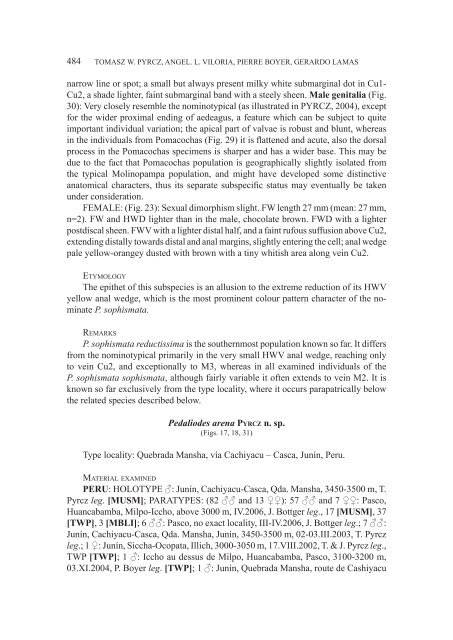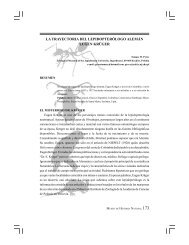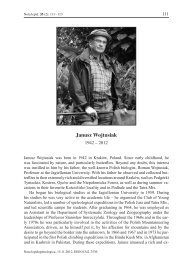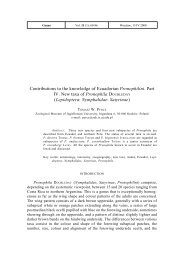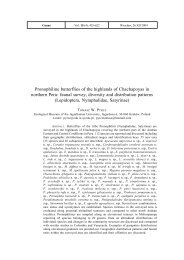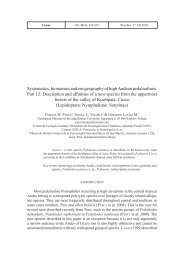Systematics, bionomics and zoogeography of high Andean ...
Systematics, bionomics and zoogeography of high Andean ...
Systematics, bionomics and zoogeography of high Andean ...
You also want an ePaper? Increase the reach of your titles
YUMPU automatically turns print PDFs into web optimized ePapers that Google loves.
484 Tomasz W. Pyrcz, Angel. L. Viloria, Pierre Boyer, Gerardo Lamas<br />
narrow line or spot; a small but always present milky white submarginal dot in Cu1-<br />
Cu2, a shade lighter, faint submarginal b<strong>and</strong> with a steely sheen. Male genitalia (Fig.<br />
30): Very closely resemble the nominotypical (as illustrated in PYRCZ, 2004), except<br />
for the wider proximal ending <strong>of</strong> aedeagus, a feature which can be subject to quite<br />
important individual variation; the apical part <strong>of</strong> valvae is robust <strong>and</strong> blunt, whereas<br />
in the individuals from Pomacochas (Fig. 29) it is flattened <strong>and</strong> acute, also the dorsal<br />
process in the Pomacochas specimens is sharper <strong>and</strong> has a wider base. This may be<br />
due to the fact that Pomacochas population is geographically slightly isolated from<br />
the typical Molinopampa population, <strong>and</strong> might have developed some distinctive<br />
anatomical characters, thus its separate subspecific status may eventually be taken<br />
under consideration.<br />
FEMALE: (Fig. 23): Sexual dimorphism slight. FW length 27 mm (mean: 27 mm,<br />
n=2). FW <strong>and</strong> HWD lighter than in the male, chocolate brown. FWD with a lighter<br />
postdiscal sheen. FWV with a lighter distal half, <strong>and</strong> a faint rufous suffusion above Cu2,<br />
extending distally towards distal <strong>and</strong> anal margins, slightly entering the cell; anal wedge<br />
pale yellow-orangey dusted with brown with a tiny whitish area along vein Cu2.<br />
Etymology<br />
The epithet <strong>of</strong> this subspecies is an allusion to the extreme reduction <strong>of</strong> its HWV<br />
yellow anal wedge, which is the most prominent colour pattern character <strong>of</strong> the nominate<br />
P. sophismata.<br />
Remarks<br />
P. sophismata reductissima is the southernmost population known so far. It differs<br />
from the nominotypical primarily in the very small HWV anal wedge, reaching only<br />
to vein Cu2, <strong>and</strong> exceptionally to M3, whereas in all examined individuals <strong>of</strong> the<br />
P. sophismata sophismata, although fairly variable it <strong>of</strong>ten extends to vein M2. It is<br />
known so far exclusively from the type locality, where it occurs parapatrically below<br />
the related species described below.<br />
Pedaliodes arena Pyrcz n. sp.<br />
(Figs. 17, 18, 31)<br />
Type locality: Quebrada Mansha, vía Cachiyacu – Casca, Junín, Peru.<br />
Material examined<br />
PERU: HOLOTYPE ♂: Junín, Cachiyacu-Casca, Qda. Mansha, 3450-3500 m, T.<br />
Pyrcz leg. [MUSM]; PARATYPES: (82 ♂♂ <strong>and</strong> 13 ♀♀): 57 ♂♂ <strong>and</strong> 7 ♀♀: Pasco,<br />
Huancabamba, Milpo-Iccho, above 3000 m, IV.2006, J. Bottger leg., 17 [MUSM], 37<br />
[TWP], 3 [MBLI]; 6 ♂♂: Pasco, no exact locality, III-IV.2006, J. Bottger leg.; 7 ♂♂:<br />
Junín, Cachiyacu-Casca, Qda. Mansha, Junín, 3450-3500 m, 02-03.III.2003, T. Pyrcz<br />
leg.; 1 ♀: Junín, Siccha-Ocopata, Illich, 3000-3050 m, 17.VIII.2002, T. & J. Pyrcz leg.,<br />
TWP [TWP]; 1 ♂: Iccho au dessus de Milpo, Huancabamba, Pasco, 3100-3200 m,<br />
03.XI.2004, P. Boyer leg. [TWP]; 1 ♂: Junín, Quebrada Mansha, route de Cashiyacu


